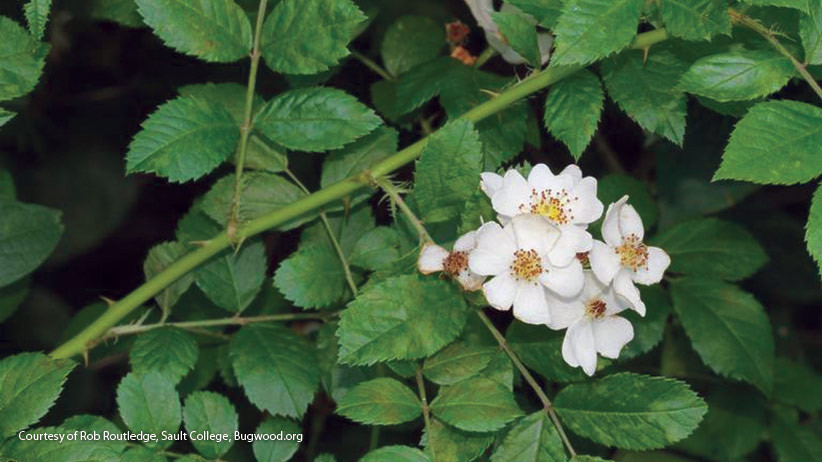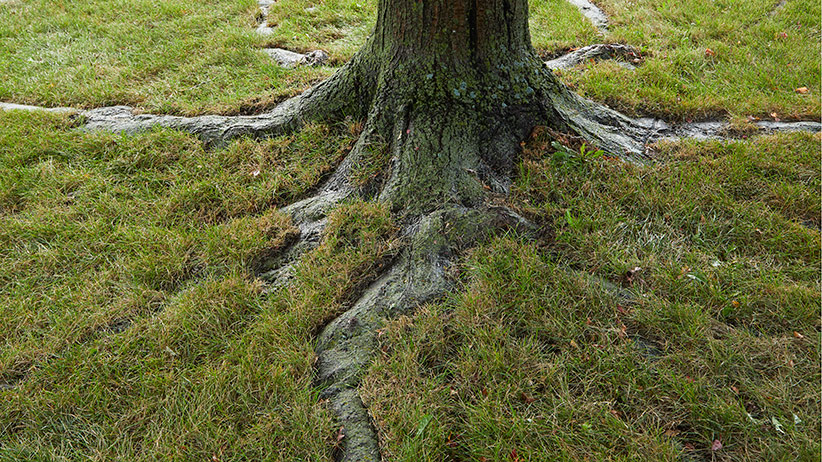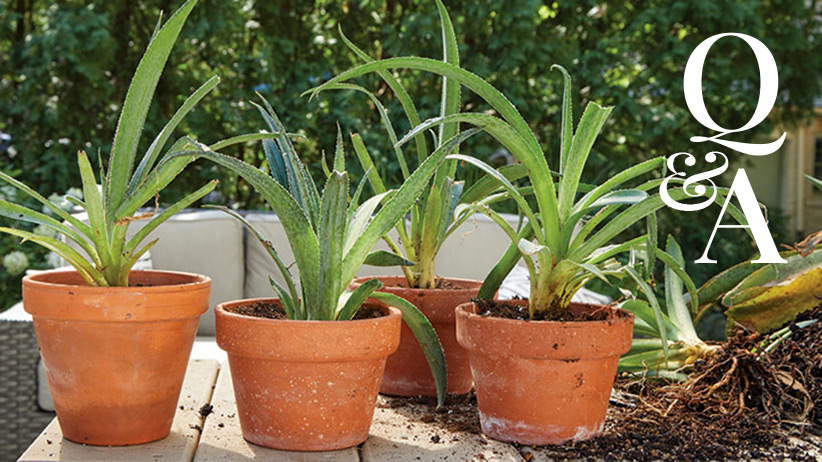Ways to invite or deter wildlife in your garden
If you read our reader submitted tips from Garden Gate, you know you'll find some great ways to recycle stuff or make gardening easier. Here are 12 smart tips for making wildlife more welcome or for keeping them out of your garden.
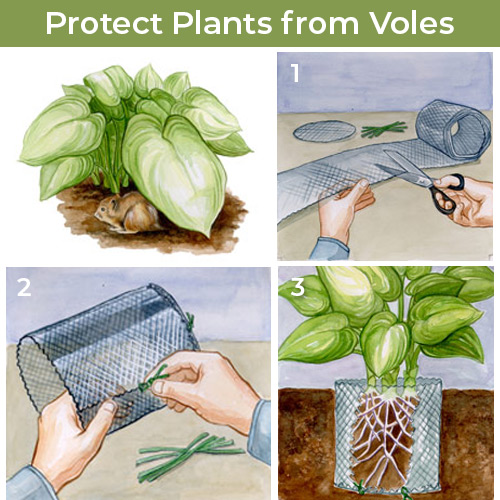
Protecting plants from voles
If you’re having trouble with voles devouring your plant roots and crowns, try this protective caging designed by Mary Rew in Virginia. The voles in Mary’s garden love to eat her hosta roots. After a lot of frustration and heartbreak, she came up with this clever, proactive idea. With gutter guard (wire meshing that keeps leaves out of gutters) and plant twist ties, she creates root baskets that pesky, persistent voles can’t chew through.
What you'll need
- Old pair of scissors
- Plant twist ties (available at your local garden center) which are larger than what you use in the kitchen
- A roll of metal gutter guard, which comes in 20-ft. rolls, and is available at hardware stores. She made the baskets out of gutter guard because it’s just the right width and bends easily.
How to make root baskets to deter voles
- The first step in making a basket is to cut a 2-to 4-ft. length of gutter guard depending on the size of the plant.
- Curve the gutter guard to make a circle, overlap the edges just a bit and reinforce the seam with a few twist ties. Be sure to tie them tight enough so the voles can’t chew their way through them.
- The next step is making the bottom of the basket. Measure the diameter of the body of the basket, then add about 1/2 in. all the way around it and cut out a circle. Attach the circle the same way you did the seam of the basket.
- Now it’s time to plant the baskets. Carefully dig up your existing plants. Then set a basket into each planting hole. Let a bit of the edge of the basket peek out of the ground so you can keep track of which plants have baskets. Don’t worry — the foliage will disguise it.
- Throw some soil in the bottom of the basket and replant your perennial. It takes a little time to make and plant these baskets, but it’s worth it!
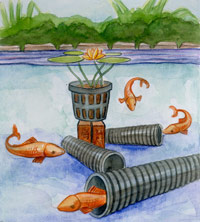
How to deter raccoons in koi ponds
Raccoons have been known to cause trouble in water gardens. Many gardeners visit their ponds each morning only to find that their aquatic plants were knocked over by bandits in the night. Worse yet, they find that their fish have completely vanished — most likely fallen prey to hungry critters. Shila Clement in California found a way to fight back.
Create a place for koi fish to hide from predators
She creates safe havens in her pond with sewer pipes. Because her pond is long and shallow, it’s a perfect feeding trough for visiting raccoon. So Shila put several pieces of sewer pipe in the pool. This way, when the raccoons come to dine, their intended meal can safely hide in the heavy pipe. Shila uses galvanized sewer piping, which works well but is expensive. You could also use black plastic sewer piping and weigh it down with a 3/8-inch piece of rebar (available at hardware stores). Black plastic piping is inexpensive and won’t show against the bottom of the pool. With a hacksaw, cut down the piping to match the length of the rebar. Then slip the rod into the pipe and sink them in the water.
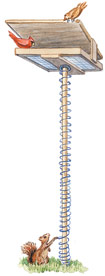
Slinky squirrel baffle
Squirrels are a real pain for gardeners like Joyce Fox who likes to feed birds. But a Slinky®, just like the one you had as a kid, has the squirrels in her North Carolina yard baffled. And it keeps the bird feeders safe! Joyce fastens a Slinky to the bottom of each bird feeder and slides it down over the pole. The moving wires keep the squirrels from climbing the pole. A staple or two will attach a Slinky to the bottom of wooden feeders, while a loop of wire secures the toys to upright tube feeders. Joyce said she tried the colored Slinkies but thought they were too gaudy. However, the plain metal ones are barely visible. Her Slinkies haven’t stretched out of shape in a year, and the squirrels are still confused!
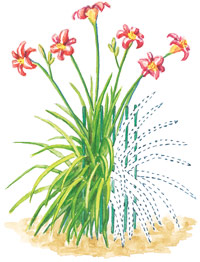
Use bamboo stakes to save daylilies from deer
Deer gobble up daylilies like candy, and Jeff Dunkerson of Kentucky didn’t want to lose his plants. But he didn’t want to hide them behind a fence, either. After some trial and error, Jeff found that a bundle of inexpensive bamboo stakes can work wonders.
He bought green bamboo stakes so they would blend in with the foliage. Next, he cut them to various heights. When the foliage started to appear, Jeff inserted up to 10 of the shorter stakes around each plant, with the tops just below the new foliage. As the daylilies grew, he pulled the stakes higher, like those in the illustration above, to keep up with the growing leaves. Sometimes he had to replace shorter stakes with longer ones. Bumping into all those blunt stakes caused the deer to move on to greener pastures by the time the daylilies were ready to bloom!
You Might Also Like:
Deer Deterrant products
How to Grow Great Daylilies
Unique Daylilies for Your Garden
Deer & Rabbit-Resistant Plants
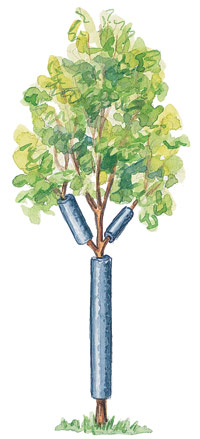
Insulate trees from deer damage
In early fall, male deer begin to grow new antlers, which are covered in a soft velvet. To get rid of the covering, they rub their antlers on young tree trunks and limbs, damaging the tree in the process. Sy Brittma of New York tried everything to keep the deer away. Finally, he found a solution: Pre-slit foam pipe insulation. It’s easy to cut to whatever length you need. And the slit on the side lets you slip the insulation over the trunk, or even the lower branches as you see in the illustration above.
This type of foam insulation comes in various sizes, so measure around your tree trunk before heading to the hardware store. You might want to secure the foam with a couple of pieces of duct tape to keep it from getting pulled off. Sy leaves the insulation on his trees all year to keep deer from nibbling at the bark, and his trees don’t have any problems. But if deer are only a problem in your area from time to time, you might want to take the insulation off when it’s not needed to prevent splitting, disease or insect problems.
Invisible fencing
If you have trouble with deer snacking on your garden and you don’t want a visual barrier, try this fencing idea from Mimi Knick in Wisconsin. She gives new meaning to the term “invisible fencing” by stringing fishing line between corner posts. She says it’s a lot cheaper than a real fence and it’s practically invisible.
Creating the invisible fence
The first thing you need to do is place posts around the garden no more than 10 feet apart. To create the fence, stretch 30-lb. to 50-lb.-test monofilament fishing line between the posts, wrapping it tight around each post to keep it from sagging. Mimi makes three rows of fishing line: one about 1 foot above the ground, another 1½ feet above the first and a third row 2½ feet above the second. Then she camouflages the posts by planting climbing flowers at their feet. Mimi says this fencing really works. “We haven’t had another deer in any of our gardens since. It appeared that the deer hit the lines and were frightened away.” (But keep in mind that if they’re hungry enough, the deer may still break through.)
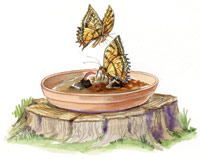
Butterfly health club
Attracting butterflies to your garden is a win-win situation. They get food and water, and you get to enjoy watching them. Sarah Horton from Alabama discovered that a moist area is almost as attractive to butterflies as her colorful flowerbeds. She places a terra-cotta saucer on an old tree stump in full sun and fills it with sand. On top of the sand she adds a small dollop of cattle or horse manure and pours in enough water to keep the whole thing moist. If Sarah has an overripe piece of fruit, she puts that in the saucer, too. Butterflies gather minerals through the water they drink. And both manure and fruit contain lots of minerals that dissolve in water. Just keep the saucer moist, and you’ll have butterflies visiting all season.
You Might Also Like:
DIY Butterfly Puddler
Best Flowers for Butteflies
Pollinator-Friendly Garden Border
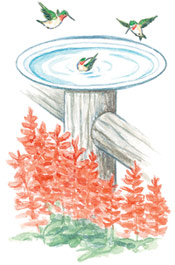
Simple hummingbird birdbath
Pauline Prentiss of Oregon noticed that hummingbirds never seemed to go near the birdbaths she’d set up. She thought the water level in her conventional baths might be too deep for the tiny creatures. So she got a large, shallow ceramic serving platter from a thrift shop. Then she ran a bead of liquid construction adhesive around the bottom of the platter. Finally, Pauline pressed the platter on top of a wooden fence post in a sheltered area near the hummingbirds’ favorite flower bed. Her idea worked! The ½ inch of clear water in the platter is just the right depth for the little birds to dunk, drink, bathe and preen their feathers to their heart’s content.
Easy dipped pinecone bird treats
Making peanut-butter-covered pinecone treats to feed the birds in winter is something Debbie Peck of Michigan learned from her grandmother. Her special tip that makes this project move along smoothly? Melt the peanut butter first. Debbie’s grandmother placed the glass jar of peanut butter in a pan of boiling water. You can speed the process if you scoop the peanut butter into a bowl and warm it up in the microwave. Swirl each pinecone in the soft peanut butter, then dip it into a bowl of birdseed. Next, lay it on waxed paper to dry. One 18-oz. jar of peanut butter covers a few dozen small pinecones. Add a string to the stem and this treat is ready to hang outside for your feathered friends!
More Bird Projects:
Best Birdseed for Your Feeders
Terra-Cotta Bird Feeder Project
DIY Bird-Feeder Wreath
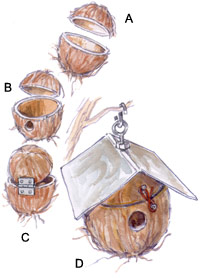
DIY coconut wren birdhouse
Eleanor Campbell from Pennsylvania prepares for the spring arrival of wrens by making coconut birdhouses. First, she chooses a coconut with about a 16-in. circumference, drills a hole at the very top of the shell and drains out the milk. Later, this hole will be used for the eye-bolt that holds the roof in place and hangs the house. Second, she cuts off the top third of the shell (A). Coconuts are very hard, so Eleanor uses a fine-bladed hacksaw to make the cuts. She cleans out the meat and saves it so she can bake a cake for her friends later. Third, she drills a 1 1/8-in. entrance (the recommended size for wrens) in the side of the coconut (B). On the side opposite the hole, four short bolts hold a small hinge in place (C). So she can open the house for next season’s cleaning, Eleanor makes a simple latch for the lid. She inserts one small screw on the top part and one on the bottom, and twists a wire between them to hold the house shut.
For extra protection, Eleanor forms a peaked roof from metal flashing purchased from the hardware store. She cuts it to about the size of a car license plate, drills a hole in the center and bends it into a “V” shape (D). She threads a nut all the way onto an eye-bolt, next slides on the metal roof and then the top portion of the shell. Inside she fastens everything together with a lock washer and another nut.
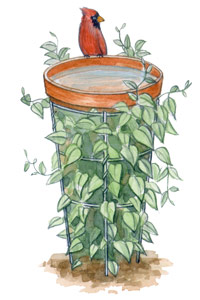
Budget-friendly tomato cage birdbath
When you’re starting a garden on a budget, items like birdbaths and arbors can be dreamed-about luxuries for “someday.” But Beth Francisco of Colorado created a birdbath that almost anyone can afford. She bought a tomato cage, a large plastic flower-pot saucer (the kind that looks like terracotta), some string and vines, such as clematis, moonflower or morning glory. She tied the string in a crisscross pattern between the rings on the tomato cage, then anchored the cage in the ground. Next, she set the plastic saucer in the top of the tomato cage and planted her vines around the “trellised” tomato cage’s base. Then all that was left was to sprinkle some decorative gravel in the tray and fill it with water.
This birdbath is easy to clean up, too. Just lift the tray out of the tomato cage, rinse it and refill. Beth also says she spray painted her tomato cage green and used green string to help it blend in and show off the real attractions: blooming vines and bathing birds.
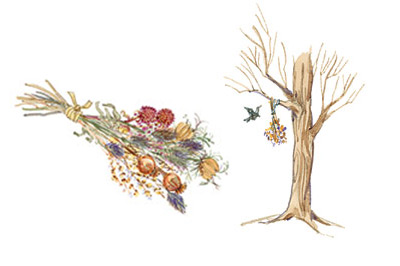
Bouquets for birds
Throwing away all of the seedheads after deadheading always seemed like such a waste to Gladys Peterson from Minnesota. One summer she saved her prettiest ones to tuck into wreaths for outdoor winter decorations. What a surprise when nuthatches, finches and many other birds flocked to the dried seedheads! They were feasting on the coneflower, sunflower, hollyhock and sedum. Now she ties her deadhead trimmings into bundles, using pieces of raffia or ribbon, to hang outside. For her feathered friends, having flower seeds out of season is as tasty as humans having fresh strawberries out of season.









